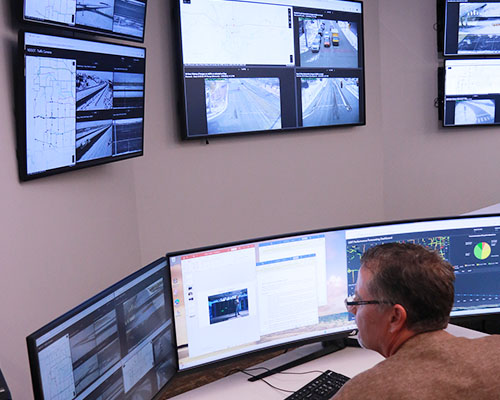UGPTI Opens High-Tech Transportation Data Intelligence Lab
Posted: Jul 30, 2025
 With funding from the North Dakota Legislature, the Upper Great Plains Transportation Institute (UGPTI) recently launched its Transportation Data Intelligence Lab, a high-tech classroom and data center that allows researchers to collect information on traffic and road conditions from a variety of cameras and sensors across the state. The goal is to provide workers and support to transportation agencies in making critical decisions on planning, designing, constructing, maintaining, and operating the state’s roadways system.
With funding from the North Dakota Legislature, the Upper Great Plains Transportation Institute (UGPTI) recently launched its Transportation Data Intelligence Lab, a high-tech classroom and data center that allows researchers to collect information on traffic and road conditions from a variety of cameras and sensors across the state. The goal is to provide workers and support to transportation agencies in making critical decisions on planning, designing, constructing, maintaining, and operating the state’s roadways system.
“The lab is designed to emulate a modern traffic management center or traffic operations center,” noted UGPTI program director Brad Wentz. Similar centers are being planned for use statewide in North Dakota and in the Fargo-Moorhead area. UGPTI’s lab will serve as a training ground for students who will work in those centers. “They require a pretty large workforce, because typically they are staffed 24 hours a day seven days a week.”
A second purpose of the lab is to connect to all the data sources across the state from state, county, city and Tribal agencies. Sources may include weather stations, weigh-in-motion sensors, traffic counters, and the hundreds of traffic cameras positioned along highways and streets from one end of the state to the other.
“We’re developing artificial intelligence (AI) models here and we’ll use the data from the center to train those models to assist in managing roadway assets and traffic,” Wentz said.
In addition to equipping the lab, funding from the ND Legislature was used to procure a very powerful computer server dedicated to the AI applications being developed and tested in the lab. The models will be trained using data flagged by students and staff. Once trained, the models will be able to automatically identify road maintenance and traffic issues. “Monitoring will be instant and continuous so that state and local road managers can take appropriate action,” Wentz said. “The use of the data and the AI models will give local agencies tools to identify and address critical issues more rapidly and prioritize needs so they can be addressed more economically.”
The data and information collected at the lab will also assist UGPTI in analyzing road conditions across the state and assess the need for road maintenance. “That information can be provided back to legislators so that they have a more accurate picture of the funding needed to manage the system across the state,” Wentz said.
In addition to AI, several other emerging technologies and techniques will be used to collect, transmit, process, and analyze data for managing transportation systems and conducting research at the lab, including:
- Edge computing components that will collect data, run algorithms, perform results, and communicate data at low cost.
- Internet of Things components that communicate data packets to online data servers.
- Power components to provide long-term power at low cost.
- Sensors, including video, infrared image, radar/lidar, ultrasonic, vibration, and soil moisture and temperature sensors.
- Connected vehicles that are equipped with vehicle-to-everything technologies and can capture geo-referenced data such as speed, trajectory information, acceleration, and other data.
“With the technology and models available in the Transportation Data Intelligence Lab, we are able to assist NDDOT and local agencies by providing information on a real-time basis so they can make decisions and provide info to the public and others, which will in turn improve the efficiency, operation and the safety of the transportation system,” Wentz said.